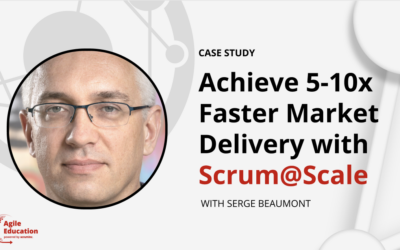Scrum@Scale Case Study
Driving Development: New Demands In A Constantly Changing Environment
Learn how Registered Scrum@Scale Trainer Martin Berendt led this automotive software company to move with more velocity starting at the top. Martin organized 10 high-caliber executives who transformed this software company from Waterfall to Scrum in just four Sprints. They became faster, more transparent, and employees increased in expertise as they self-organized into teams.
CASE STUDY SNAPSHOT
Trainer Name: Martin Berendt
Organization: EFS
Industry: Automobile Software
Topic: Executive Action Team (EAT)
Organization Size: Large
Date: 2020
Website: Martin’s LinkedIn
Scrum@Scale Case Study Summary
EFS is a software company that increases development speed and quality of the client by providing virtual vehicles and environments so that the client can access the performance of the vehicle and driving behavior without building the car. They work in a constantly changing environment with new clients, vehicle platforms, and multiple competing requirements and priorities. While some worried that changes to their traditional way of doing business could impede their progress, the new demands required them to go faster with higher transparency. Becoming Agile not fragile was the answer.
The Solution: Executive Action Team (EAT) Paving The Way
Registered Scrum@Scale trainer Martin Berendt led this company, completely new to Scrum by starting at the top! Ten high-caliber executives became the Executive Action Team (EAT) with the goal of having three Scrum teams up and running after just four sprints. Under Martin’s guidance they trained and certified managers and employees, transparently mapped all projects to products and self-organized Scrum teams, and aligned the teams and clients. The new organization consisted of one (EAT), three Scrum teams, one Scrum Master Team, and one Product Owner Team. Under the direction of the EAT, this company went from no background in Scrum to functional Scrum teams in just four Sprints. The results were clear in the first 100 days, with increased velocity, transparency, motivation, and focus.
Outcomes from Implementing Scrum@Scale
The results of moving from the Waterfall to Scrum were immediately evident. In just 100 days, the following changes were documented with more quantitative data on the way as the progress continues.
- Employees self-organized into new areas of expertise
- Transparency about team velocity
- Less weight on Vice President’s shoulders
- Executives continue working as the EAT
- Increased focus
Who Is Martin Berendt?
Registered Scrum@Scale Trainer and Agile Coach Martin Berendt is Co-Founder of the Scrum Supply Company. With 10 years of industry experience, he helps companies to break new grounds with innovative solutions.
At BMW, he was Chief Product Owner and one of the first Project Managers to transition from classic Project Management to Agile Project Management. Within the pilot project of the Agile Process Planning Framework, he led five Product Owners and Development Teams designing new engine assembly lines.
As a Senior Consultant at A.T. Kearney, Martin helped to implement Agile Methods in Product Development and Project Management in the Automotive and Industry Sector with focus on maximizing value for customers.
At HelloFresh he enabled the company to become the leading meal-kit delivery provider by implementing Scrum and Kanban in Production and Automation and designing and implementing production systems in six fulfillment centers around the world as Global Vice President.
Martin has a “Diplom-Ingenieur” Degree in Mechatronics from the University of Stuttgart with majors in Control Theory and Process Automation and a Master of Science Degree in Mechanical Engineering from the University of Massachusetts.



